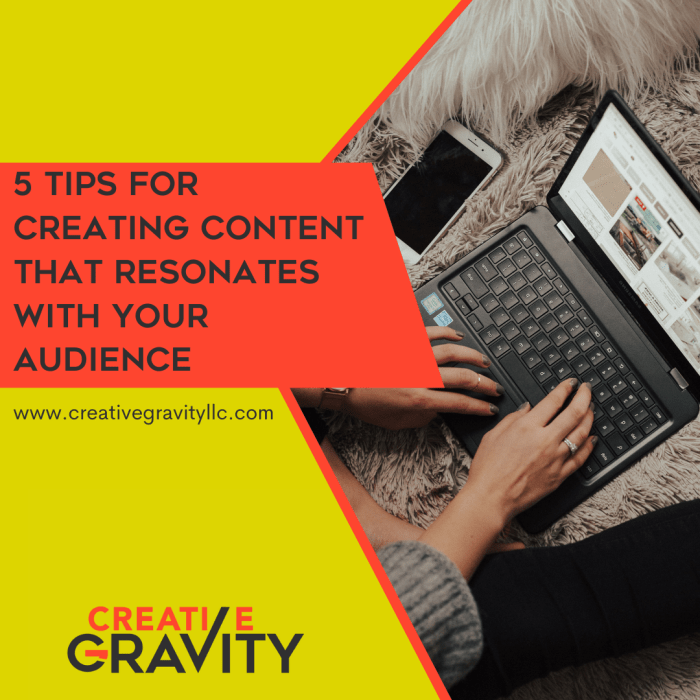Creating Content That Resonates sets the stage for captivating storytelling, diving into the world of audience engagement with an irresistibly cool vibe. Get ready to discover the secrets of crafting content that truly connects.
From understanding your audience to mastering visual appeal, this guide will take you on a journey to create content that leaves a lasting impact.
Understanding Your Audience: Creating Content That Resonates
When it comes to creating content that hits the right spot, understanding your audience is key. You gotta know who you’re talking to, what they like, and how they engage with content. This ain’t no guessing game, it’s all about doing the research and getting those insights.
Importance of Audience Research
Audience research ain’t just some fancy term, it’s the real deal. By knowing your audience inside out, you can tailor your content to their preferences, interests, and behaviors. This leads to higher engagement, more shares, and ultimately, building a loyal fan base.
- Use analytics tools like Google Analytics to gather data on your audience demographics, interests, and online behavior.
- Check out social media insights to see who’s interacting with your content and what they’re vibing with.
- Conduct surveys or polls to directly ask your audience about their preferences, interests, and feedback.
Methods to Identify Target Audience Demographics
To hit the bullseye with your content, you gotta know who you’re targeting. Identifying your target audience demographics helps you create content that resonates with the right peeps.
- Look at your current audience data to see who’s already engaging with your content.
- Use market research tools like Pew Research Center or Statista to gather demographic data on different age groups, locations, and interests.
- Utilize social media analytics to understand the demographics of your followers and fans.
Conducting Surveys or Interviews for Audience Insights
Sometimes, you gotta go straight to the source to get those juicy insights. Surveys and interviews can help you understand your audience on a deeper level and uncover what makes them tick.
- Create online surveys using tools like SurveyMonkey or Google Forms to gather feedback and preferences from your audience.
- Reach out to your audience for one-on-one interviews to get personal insights and stories that can shape your content strategy.
- Host focus groups to get a diverse range of opinions and perspectives from different segments of your audience.
Tools or Software for Audience Analysis
In the digital age, there’s no shortage of tools and software to help you dive deep into audience analysis. From demographics to online behavior, these tools can give you the insights you need to create killer content.
- Google Analytics: Dive into your website traffic data to understand your audience demographics, interests, and behavior.
- Social media analytics tools like Sprout Social or Hootsuite: Get detailed insights into your followers, engagement metrics, and content performance.
- Audience surveys tools like SurveyMonkey or Typeform: Create custom surveys to gather feedback and preferences from your audience.
Tailoring Content to Audience Needs

In order to create content that resonates with your audience, it is crucial to align your content with their preferences and interests. By understanding what your audience is looking for, you can tailor your content to meet their needs and provide value to them. Here are some strategies for creating personalized content experiences:
Aligning Content with Audience Preferences and Interests
To align your content with audience preferences and interests, you can conduct surveys, analyze data from your website or social media platforms, and engage with your audience directly through comments and messages. By understanding what topics, formats, and tones resonate with your audience, you can create content that is more likely to engage them.
Creating Personalized Content Experiences, Creating Content That Resonates
Personalizing content involves delivering tailored messages to specific audience segments based on their demographics, behaviors, or preferences. This can be achieved through dynamic content, personalized recommendations, or targeted email campaigns. By providing content that speaks directly to the individual needs of your audience members, you can enhance their overall experience with your brand.
The Role of Storytelling in Engaging with Different Audience Segments
Storytelling is a powerful tool for engaging with different audience segments because it allows you to create an emotional connection with your audience. By sharing stories that resonate with their experiences, beliefs, or aspirations, you can capture their attention and build a sense of trust and loyalty. Whether through video content, blog posts, or social media updates, storytelling can help you connect with diverse audience segments on a personal level.
Examples of Successful Content Personalization Campaigns
– Netflix’s personalized recommendations based on viewing history and preferences have significantly increased user engagement and retention.
– Amazon’s targeted product recommendations and personalized shopping experience have led to higher conversion rates and customer satisfaction.
– Spotify’s customized playlists and personalized music recommendations have enhanced user experience and loyalty.
Crafting Compelling Headlines and Introductions
Crafting compelling headlines and introductions is crucial in capturing the attention of your audience right from the start. A catchy headline and an engaging introduction can make the difference between someone clicking away or staying to read more.
Significance of Headlines and Introductions
Crafting attention-grabbing headlines is essential because it is the first thing your audience sees. A compelling headline should entice readers to click on your content and continue reading. Similarly, introductions play a vital role in hooking readers by setting the tone for the rest of the piece and providing a preview of what’s to come.
Tips for Writing Attention-Grabbing Headlines
- Keep it short and sweet: Aim for 6-8 words to pique curiosity.
- Use power words: Words like “ultimate,” “amazing,” or “essential” can make your headline more compelling.
- Pose a question: Asking a thought-provoking question can prompt readers to click for the answer.
- Create urgency: Use words like “now” or “today” to convey a sense of urgency.
Techniques for Creating Compelling Introductions
- Start with a quote: Using a relevant quote can draw readers in and set the tone for your content.
- Tell a story: Narratives can captivate readers and make your content more relatable.
- Pose a problem: Highlighting a common issue can make readers want to continue reading for a solution.
- Use statistics: Sharing surprising statistics can intrigue readers and make them curious to learn more.
Examples of Effective Headlines and Introductions
“10 Secrets to Boost Your Productivity Now!”
“In a world where time is money, efficiency is key. Are you ready to take your productivity to the next level?”
Utilizing Visuals and Multimedia

Visuals and multimedia play a crucial role in enhancing the appeal of content by making it more engaging and easier to understand. Incorporating images, videos, infographics, and other multimedia elements can help capture the audience’s attention and convey information more effectively.
Impact of Visuals and Multimedia
Visuals and multimedia can significantly impact the way content is perceived and understood. Studies have shown that content with relevant images receives more views and shares compared to text-only content. Videos, in particular, have become increasingly popular for delivering content due to their interactive and dynamic nature. Infographics are also effective in presenting complex information in a visually appealing format.
- Choose visuals that are relevant to the content and enhance the message you want to convey.
- Ensure that the visuals are of high quality and resolution to maintain professionalism.
- Use a variety of visuals to keep the audience engaged, such as photos, illustrations, charts, and diagrams.
- Consider the preferences of your target audience when selecting visuals to ensure they resonate with them.
Examples of Successful Content with Visuals
One example of successful content that effectively integrates visuals is Buzzfeed’s Tasty videos. These short cooking videos combine engaging visuals with simple instructions, making them highly shareable and popular on social media. Another example is National Geographic’s Instagram account, which features stunning photographs and videos that complement their educational content, attracting a large following.












